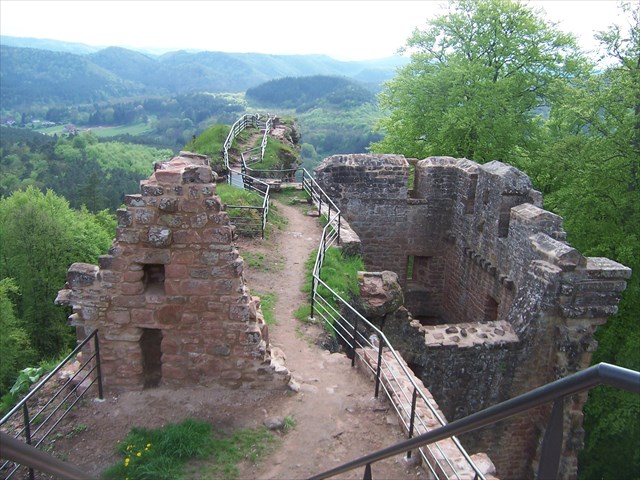 ;
;
FALKENSTEIN
Le château, édifié par le comte Pierre de Lutzelbourg, est mentionné pour la première fois en 1127. Il est destiné à protéger les possessions du comte situées dans la Forêt Sainte de Haguenau.
En 1150, Renaud, fils de Pierre, meurt sans laisser de descendant. Le château est alors partagé entre Folmar de Sarrewerden et la famille de Hohenstaufen. Jacques de Falkenstein apparaît comme témoin dans une charte signée à Haguenau en 1205 et en 1316, Gottfried, Conrad, Heinrich et Jacob de Falkenstein jurent la paix avec la ville de Strasbourg. Une paix castrale est signée en 1335, délimitant le château en trois parts au moyen de murs transversaux.
En 1419, Jean de Finstingen (Fénétrange) se dit seigneur de Falkenstein puisque usufruitier de la part des Sarrewerden ; en1474 a lieu une convention de pariage entre les Falkenstein : aucune part ne doit être cédée, même à un autre membre de la famille, sans l'accord des autres pariers. Le château revient aux comtes de Deux-Ponts-Bitche en 1479 et en 1482-1483 éclate un conflit pour le non-respect de la convention entre les membres de la famille.
Les Falkenstein sont seuls maîtres du château en 1515 et la modernisation commencée par Balthasar est continuée par ses fils. En 1564, Philippe IV (1538-1590), comte de Hanau-Lichtenberg, achète le château aux enfants et petits-enfants de Balthasar et, quelques mois plus tard, il sera complètement détruit par un incendie et ne sera jamais reconstruit.
En 1570, une partie du château non détruite continue à être habitée par un garde forestier du comte de Hanau-Lichtenberg. Entre 1570 et 1605 éclate un conflit entre les Hanau-Lichtenberg et le duché de Lorraine, au terme duquel le Falkenstein revient aux Hanau-Lichtenberg en 1606. En 1609 pourtant, l'empereur germanique investit le duc de Lorraine Henri II du fief de Falkenstein2, qui restera désormais dans cette Maison.
En 1623, le château est ruiné par les troupes de Mansfeld durant la guerre de Trente Ans, de telle sorte que les gardes forestiers ne peuvent plus y demeurer et en 1676-1677 a lieu sa destruction définitive par les troupes françaises de Montclar. L'arrière-petit-neveu de Henri II, le prince de Vaudémont, est pourtant investi du titre purement honorifique de comte de Falkenstein.
François III de Lorraine, lorsqu'il renonce au duché de Lorraine et avant de devenir empereur, s'intitule toujours comte de Falkenstein pour siéger aux diètes d'Empire ; le titre n'est plus alors assorti d'aucune possession territoriale réelle.
Le Falkenstein est classée monument historique en 1929
Falkenstein Castle: The oldest bailey castle in the Wasgau, built on a rocky outcrop.
1117/1125: The castle is constructed to protect the northern county borders. The founder was Pierre, Count of Lutzelbourg.
After 1143, the last heir to Lutzelbourg dies and the castle becomes the property of Etienne de Bar, Bishop of Metz.
In 1154, the castle is taken over by Folmar de Saarwerden and is occupied by his men. Falkenstein becomes an imperial castle, feudal de Saarwerden. From that moment on they take the name, “Lords of Falkenstein”.
In 1237, three brothers lived there: Guillaume, Jacques and Ortlieb with their families. This Falkenstein line is rich and powerful. They are vassals of the bishop and feudal overlords of Ramstein (the castle at Baerenthal which, as well as the Waldeck, has also followed a programme to enhance safety measures).
In 1335, a document found in the archives (mentioning ein burgfried or peaceful bailey) gives precious information about the Falkenstein: its occupants, its functions, its layout… It also states that it was occupied by three families: the Bronns’ (or Burns’), the Windsteins’ and the Falkensteins’. This tripartite resulted in a change to the top part of the castle. Supporting walls were built to separate the three families. The court yard buildings were communal and each family has signed the document assuring the castle guard, each one paying an armed valet to protect the property. This document also states that part of the property could be rented and it even gives the tariff: for example, for a fortnight for a Lord, it would cost 4 Strasbourg pounds and a new crossbow: for a Knight, 1 pound and a crossbow.
In 1377, during a feudal war between Falkenstein and Lichtenberg, the castle was attacked and burnt down. The Lichtenbergs’ become the overlords of Falkenstein. The Falkensteins’ remain in the castle for almost two centuries.
In 1563, after the death of the Balthazars, the castle changes hands. It is bought by Philippe IV of Hanau-Lichtenberg. The sale is finalised in February 1564 for the sum of 2400 florins. The castle is once again owned uniquely by one family.
On the 19th April in the same year, a fire caused by a lightning strike, damages the castle considerably. The owner abandons the property and builds a manor in the valley, to which he gives his name: Philippsburg. He also gave his name to the village that develops later, the actual Philippsbourg we know today. The old Falkenstein castle is not completely abandoned. The document states that a forester named Martin lived there in 1599. The property still belongs to Hanau-Lichtenberg. During the 30 Year War, the castle is burnt down in 1623 and again in 1633 when it is victim to the raids and lootings carried out by Count Manfeld’s protestant mercenaries.
The castle is completely destroyed and abandoned, as many castles were, during the reign of Louis XIV who feared that the fortresses would be used as enemy strongholds during the Holland Campaign (1677- 1678). The remains of the dwellings served as a quarry for the surrounding villages, at that time in full development. Falkenstein Castle is classed as an historical monument in 1929.
.